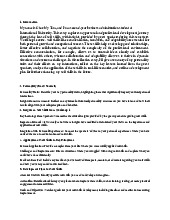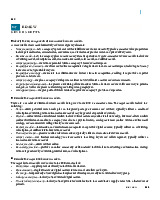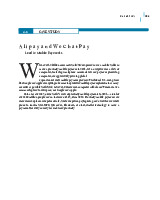








Preview text:
lOMoAR cPSD| 58583460
OPENRICE BRINGS SOCIAL E-COMMERCE TO THE TABLE
OpenRice was founded in 1999 as a restaurant-review website in Hong Kong. “Open rice” is a
literal word-for-word translation of the Cantonese phrase “hoi fan,” which means “kicking o 昀
昀 a meal.” OpenRice positioned itself as an online community for food lovers to share their
dining experiences through reviews and ratings.
OpenRice now operates in nine Asian countries and has over 1.7 million restaurant partners.
A visitor to the website can view al l the contents of OpenRice but must register as a member
to write reviews and rate eateries.
Though registration is open to all and free of charge , OpenRice understands that its users
look for fair and objective food critiques, so it has measures in place that preserve its
reputation as a credible source of information. Before being published online, each review
is vetted by the operations team to screen out paid reviews. In addition, OpenRice has
developed an algorithm that uses details such as the reviewer’s IP address and login
frequency to validate genuine food critics and eliminate ghostwriters. Comprehensive and
up-to-date information on eateries and their dishes—whether they appear as text or as
images—is key for OpenRice in acquiring, retaining, and expanding its user base. Moreover,
the website also features advertisements from clients outside the food-and-beverage (F&B)
industry to reinforce its reputation as a neutral platform.
OpenRice has seen its fair share of challenges over the years. The SARS pandemic in 2003
caused an economic recession in Hong Kong, and OpenRice’s income from online advertising
plummeted as the number of visitors to its website markedly decreased along with the interest
in eating out. It was sold to a local job-search website in Hong Kong, and the introduction
of new capital breathed new life into the business . In addition, in October 2003,
FoodEasy.com, OpenRice’s main competitor, started charging subscription fees for its
members to view complete information on restaurants, which led many of them to switch
to OpenRice . The platform gradually became a popular, prestigious, and mobile food guide
providing information on cafés, bars, bistros, and bakeries not only within Hong Kong but also
in neighboring Asian countries, including China, Taiwan, Japan, Indonesia, Malaysia, the
Philippines, Singapore, and Thailand.
Regional OpenRice websites are tailored to the taste and preferences of users based on the
location they are accessed from; the designs of the China and Philippines versions are
straightforward and uncluttered, while other regions’versions have additional functions, such
as advanced searching, restaurant bookmarking, and table-booking . On the Hong Kong
website, OpenRice provides more functions than other restaurant-booking apps such as Eatigo
and Chope, including queuing tickets, free vouchers and discount coupons, food delivery, and electronic bill settlement.
Eateries may choose to have these functions added to their pro 昀椀 le page by paying a service fee to OpenRice .
In 2014, having taken note of the rising trend on social media of sharing photos of food,
OpenRice launched OpenSnap, a food album app that automatically organizes users’ photos
by restaurant and date before they are shared on OpenRice and major social media
platforms. The app also enables users to discover restaurants by allowing them to browse
and tap on food photos suggested by the app or contributed by other members. The
interaction and engagement with its over 5 million members not only improves the user lOMoAR cPSD| 58583460
experience but also creates steady tra 昀케 c to the main site. And thanks to the increased
visitor 昀氀 ow, OpenRice is able to attract more online advertisements from its non-F&B
clients, such as banks, airlines, and shopping malls.
The growth in consumer reliance on smartphones marked a turning point for OpenRice. In
recent years, the company has witnessed accelerated revenue growth, with its mobile ad
revenue quickly eclipsing desktopbased advertisements. Besides social commerce, another
way of securing a strong mobile presence and generating steady revenues is through
cooperation with other platforms, such as through reward programs and partnerships with
credit card companies. For example, a luxury shopping arcade in Hong Kong launched its
membership app with a scan-to-order function powered by OpenRice that allows club
members to remotely place an order at any restaurant in the arcade . OpenRice also provides
a feature enabled by an application programming interface (API) through which members
can earn reward points on the interfaces of the apps of its partners, which include banks,
airlines, shopping malls, e-payment solution providers, and online trave l agencies. Banks
participating in JETCO APIX (Hong Kong’s 昀椀 rst open API exchange platform) can send
their clients e-vouchers of restaurants from OpenRice .
In 2019, OpenRice launched OpenRice Takeaway, a service through which members pre-
order, pre-pay, and pick up meals themselves. Participating eateries are charged a service
fee of 6% of the total transaction value . Demand for this service skyrocketed in 2020 as Covid-
19 broke out, but OpenRice waived all takeaway-related fees from February to June 2020
to help the beleaguered F&B industry survive the 昀椀 rst two waves of the pandemic.
Big data has created new revenue sources for OpenRice. As of January 2021, OpenRice hosted
more than 3 million reviews and over 22 million photos of about a million eateries located in
60 cities. The database enables OpenRice to compile reports that clients can access by paying
a fee, such as market insights on everything from dining trends to the average restaurant
lifespan by cuisine. Existing eateries may order bespoke reports analyzing comments from
OpenRice members to improve their overal l quality and reputation. Restaurants that intend
to expand their operations may order reports summarizing the distribution of restaurants
by district and by cuisine before making decisions on the opening of new branches. Clients
such as food courts, shopping malls, and food brands can use the database to cost-e 昀昀
ectively maximize their expos ure among the right target audience.
Clients may even recruit sta 昀昀 through OpenRice by paying a service charge . OpenRice’s
websites and its companion job-matching app disseminate information regarding vacancies
in companies within the F&B industry and even accept job applications on behalf of employers .
OpenRice also provides its clients with c onventional and creative marketing services, like
creating promotional posts on Facebook, posting advertorials, and producing high-quality
original multimedia content on OpenRice’s Video Channel. Summary: lOMoAR cPSD| 58583460
OpenRice, founded in 1999 as a restaurant-review website in Hong Kong, has evolved into a
comprehensive social e-commerce platform for food lovers across nine Asian countries. It boasts over
1.7 million restaurant partners and more than 5 million members. The platform ensures credibility
through measures like vetting reviews and employing algorithms to detect fake critiques.
Despite facing challenges such as the SARS pandemic and competition from FoodEasy.com, OpenRice
thrived by adapting and expanding its offerings. It provides tailored regional websites with various
functions like advanced searching and table-booking. In 2014, OpenRice launched OpenSnap, a food
album app, capitalizing on the trend of sharing food photos on social media.
With the rise of smartphone usage, OpenRice witnessed accelerated revenue growth, particularly in
mobile ad revenue. It diversified its revenue streams through partnerships with other platforms, reward
programs, and cooperation with credit card companies. OpenRice Takeaway, introduced in 2019,
experienced increased demand during the Covid-19 pandemic, prompting the platform to waive all
related fees to support the struggling F&B industry.
Harnessing big data, OpenRice offers valuable insights and reports to clients, ranging from dining trends
to restaurant lifespan analysis. It also provides marketing services and facilitates recruitment for F&B businesses. Key Contents:
1. Evolution from a restaurant-review website to a comprehensive social e-commerce platform.
2. Measures to ensure credibility, including vetting reviews and using algorithms.
3. Adaptation and expansion despite challenges like the SARS pandemic and competition.
4. Tailored regional websites with various functions.
5. Launch of OpenSnap to capitalize on the trend of sharing food photos.
6. Revenue growth driven by increased mobile ad revenue.
7. Diversification of revenue streams through partnerships and cooperation.
8. Introduction of OpenRice Takeaway and waiving of fees during the Covid-19 pandemic.
9. Utilization of big data for valuable insights and reports.
10. Provision of marketing services and recruitment facilitation for F&B businesses.
In this case, the key components of the e-commerce business model employed by OpenRice include:
OpenRice's business model encompasses multiple roles:
1. E-Tailer: Providing a platform for users to browse and order food from restaurants,
includingthe takeaway service. lOMoAR cPSD| 58583460
2. Community provider: Creating an online community for food lovers to share reviews,
ratings,and photos of dining experiences.
3. Content creator: Generating user-generated content such as restaurant reviews, ratings, and photos.
4. Market creator: Facilitating interactions between consumers and restaurants, creating a
marketplace for food-related services.
5. Service provider: Offering various services such as job-matching, marketing, and market
insights to restaurants, food brands, and other clients.
6. Portal: Serving as a central hub for users to access information and services related to dining experiences. 1. Services provided: •
Restaurant reviews and ratings platform •
Social media integration through OpenSnap • Food album app •
Mobile app features like queuing tickets, vouchers, and discounts • Takeaway service •
Big data analytics and market reports •
Job-matching services for the F&B industry •
Conventional and creative marketing services •
Online advertising, including mobile ad revenue •
Service fees from eateries for additional features •
Subscription fees for access to market reports •
Service fees from job-matching services •
Revenue sharing from takeaway service
4. Value o 昀昀 ered:
Reliable and credible restaurant reviews for users
Enhanced user experience through social media integration
Revenue generation opportunities for eateries through additional services
Market insights and analytics for clients
Cost-e 昀昀 ective marketing solutions
Job recruitment services for the F&B industry
1. Platform Model: OpenRice operates as a platform connecting restaurants and food lovers. It
facilitates transactions such as bookings, ordering, and takeaway services.
2. Social Commerce Integration: OpenRice incorporates social elements into its platform, such as user-
generated content, sharing features, and social media integration. This enhances user engagement and drives traffic. lOMoAR cPSD| 58583460
3. Revenue Streams Diversity: OpenRice diversifies its revenue streams beyond traditional
advertisingby offering services like restaurant partnerships, takeaway services, and providing valuable
insights and reports to clients for a fee.
4. Mobile Commerce Focus: With the rise of smartphone usage, OpenRice places a significant
emphasis on mobile commerce, optimizing its platform and services for mobile devices and generating
revenue through mobile ads and partnerships.
5. Data Monetization: OpenRice leverages the vast amount of data it collects to offer valuable insights
and reports to clients, creating an additional revenue stream through data monetization.
6. Partnership and Integration: OpenRice collaborates with other platforms, credit card companies,
andbusinesses to enhance its services, generate additional revenue, and expand its reach.
7. Customer-Centric Approach: OpenRice prioritizes user experience by providing tailored regional
websites, innovative features like OpenSnap, and services such as queuing tickets, vouchers, and
discounts, all aimed at enhancing customer satisfaction and retention.
8. Adaptation to Market Trends: OpenRice adapts to market trends, such as the rise of social media
food sharing, by launching new features like OpenSnap to meet evolving user preferences and behaviors.
Overall, OpenRice's e-commerce business model demonstrates a comprehensive approach that
combines social elements, revenue diversification, data monetization, and partnerships to create value
for both users and businesses in the food and beverage industry.
Certainly! Based on the provided case study, here are some main points and possible answers for
questions related to e-commerce business strategies, particularly focusing on Chapter 2 topics:
1. Market Segmentation and Targeting:
- OpenRice operates in nine Asian countries, tailoring its websites to the preferences of users based on their locations.
- It offers additional functions in different regions to cater to specific user needs, such as advanced
searching, restaurant bookmarking, and table-booking.
2. Positioning and Differentiation:
- OpenRice positioned itself as an online community for food lovers to share dining experiences through reviews and ratings.
- It differentiates itself by providing comprehensive and up-to-date information on eateries and
dishes, validated by measures to ensure credibility.
- The introduction of OpenSnap capitalized on the trend of sharing food photos on social media, enhancing user engagement. lOMoAR cPSD| 58583460 3. Revenue Models:
- OpenRice generates revenue through various means, including advertisements, subscription fees for
additional services for eateries, and service fees for takeaway transactions.
- It leverages its large database to offer market insights reports to clients for a fee.
- OpenRice charges a service fee for providing job-matching services to employers in the F&B industry. 4. Mobile Commerce:
- OpenRice has adapted to the growth in smartphone usage by focusing on mobile ad revenue and
developing mobile-centric features such as scan-to-order functionality.
- The OpenRice Takeaway service and partnership with JETCO APIX further emphasize the
company's commitment to mobile commerce.
5. Partnerships and Alliances:
- OpenRice collaborates with other platforms, such as credit card companies and luxury shopping
arcades, to enhance its services and generate additional revenue streams.
- It offers a feature enabled by API through which members can earn reward points on partner platforms. 6. Data Monetization:
- OpenRice utilizes big data to compile reports for clients, providing market insights and analysis
based on user-generated content.
- It offers customized reports for existing eateries looking to improve their quality and reputation or
for those planning to expand their operations.
7. Customer Relationship Management (CRM):
- OpenRice fosters engagement with its over 5 million members through features like OpenSnap
andinteractive functionalities on its websites and apps.
- It offers conventional and creative marketing services to clients, such as promotional posts on social
media and original multimedia content production, to enhance their visibility and engagement with their target audience.
These points cover various aspects of e-commerce business strategies as discussed in Chapter 2 of
ecommerce textbooks. They can serve as potential answers or discussion points for related questions in a quiz.
E-Tailer, Community provider, content creator, market creator, service provider, affiliate, portal or transaction broker? lOMoAR cPSD| 58583460
1. Why should the customer buy from you? – VALUE PROPOSITION
- Customers should buy from OpenRice because it provides a comprehensive platform for food lovers
to share dining experiences, access up-to-date information on eateries and dishes, and benefit from
features like reviews, ratings, and food photo sharing. OpenRice ensures credibility by vetting reviews
and utilizing algorithms to detect genuine critiques, thus offering customers a reliable source of
information for their dining choices.
2. How will you earn money? – REVENUE MODEL
- OpenRice earns money through various revenue streams:
- Advertising revenue from both F&B and non-F&B clients.
- Service fees from eateries for additional features like queuing tickets, vouchers, and table-booking.
- Transaction fees from the OpenRice Takeaway service.
- Selling market insights reports and customized analytics based on user-generated content.
- Charging service fees for job-matching services within the F&B industry.
3. What market space do you intend to serve, and what is its size? – MARKET OPPORTUNITY
- OpenRice serves the market space of food and dining experiences in nine Asian countries, including
China, Taiwan, Japan, Indonesia, Malaysia, the Philippines, Singapore, Thailand, and Hong Kong. The
size of this market space is significant, given the widespread popularity of dining out and the vast
number of restaurants and eateries across these countries.
4. Who else occupies your intended marketspace? – COMPETITIVE ENVIRONMENT
- Other competitors in the food and dining market space include restaurant review platforms, food delivery
services, restaurant booking apps, and local restaurant guides. Direct competitors may include platforms
like FoodEasy.com (mentioned in the case study), while indirect competitors could include food bloggers,
social media platforms, and traditional print guides.
5. What special advantages does your firm bring to the market space? – COMPETITVE ADVANTAGE
- OpenRice brings several advantages to the market space, including:
- A comprehensive platform offering reliable reviews and ratings vetted for credibility.
- Innovative features like OpenSnap, catering to the trend of food photo sharing on social media.
- Mobile-centric services and partnerships, capitalizing on the growth in smartphone usage.
- Big data analytics capabilities, providing valuable market insights and customized reports for clients.
- A wide network of over 1.7 million restaurant partners across nine Asian countries, ensuring extensive
coverage and accessibility for users.
6. How do you plan to promote your products or services to attract your target audience? – MARKET STRATEGY
- OpenRice promotes its products and services through various channels:
- Social media marketing, including promotional posts and advertorials.
- Partnerships with banks, airlines, shopping malls, and other non-F&B clients for cross-promotion and advertisement.
- Mobile app features like OpenSnap, enhancing user engagement and driving traffic to the platform. lOMoAR cPSD| 58583460
- Collaborations with credit card companies and luxury shopping arcades for enhanced services andvisibility.
- Offering rewards and incentives to users and partners for increased engagement and loyalty.
7. What types of organizational structures within the firm are necessary to carry out the
business plan? – ORGANIZATIONAL DEVELOPMENT
- Organizational structures within OpenRice may include:
- Operations team for vetting reviews and maintaining platform integrity.
- Sales and marketing team for advertising sales and partnerships.
- Product development and technology team for app development and feature enhancements.
- Data analytics team for generating market insights reports.
- Customer support team for user inquiries and issue resolution.
8. What kinds of experiences and background are important for the company’s leaders to have? – MANAGEMENT TEAM
- Leaders within OpenRice should ideally have experiences and backgrounds in:
- Technology and digital innovation, to drive product development and stay abreast of industry trends.
- Marketing and sales, to effectively promote the platform and secure advertising partnerships.
- Data analytics and market research, to leverage the platform's data for insights and revenue generation.
- Operations and customer service, to ensure platform integrity and user satisfaction.
- Business development and partnerships, to forge alliances and expand the platform's reach and services. 1. Value Proposition:
- OpenRice offers a comprehensive platform for food lovers to share dining experiences, access up-
to-date information on eateries and dishes, and benefit from features like reviews, ratings, and food photo sharing. lOMoAR cPSD| 58583460
- The platform ensures credibility by vetting reviews and utilizing algorithms to detect genuine
critiques, providing users with a reliable source of information for their dining choices. 2. Revenue Model:
- OpenRice generates revenue through various streams, including advertising from both F&B and non-
F&B clients, service fees from eateries for additional features, transaction fees from the OpenRice
Takeaway service, selling market insights reports, and charging service fees for job-matching services within the F&B industry. 3. Market Opportunity:
- OpenRice serves the market space of food and dining experiences in nine Asian countries, catering
to the widespread popularity of dining out and the vast number of restaurants and eateries across these countries.
4. Competitive Environment:
- Competitors in the food and dining market space include other restaurant review platforms, food
delivery services, restaurant booking apps, food bloggers, social media platforms, and traditional print
guides. Direct competitors may include platforms like FoodEasy.com, while indirect competitors could
include local restaurant guides.
5. Competitive Advantage:
- OpenRice offers several advantages, including a comprehensive platform with reliable reviews,
innovative features like OpenSnap, mobile-centric services and partnerships, big data analytics
capabilities for market insights, and a wide network of restaurant partners across multiple countries. 6. Market Strategy:
- OpenRice's market strategy includes promoting its products and services through social media
marketing, partnerships with non-F&B clients for cross-promotion and advertisement, mobile app
features like OpenSnap, collaborations with credit card companies and luxury shopping arcades, and
offering rewards and incentives to users and partners for increased engagement and loyalty.
7. Organizational Development:
- Organizational development within OpenRice may involve establishing departments such as
operations, sales and marketing, product development and technology, data analytics, and customer
support to support the platform's growth and maintain its operations effectively. 8. Management Team:
- The management team at OpenRice should ideally have experiences and backgrounds in technology
and digital innovation, marketing and sales, data analytics and market research, operations and customer
service, business development and partnerships, to effectively drive the platform's development,
promotion, growth, and expansion in the competitive market space.



